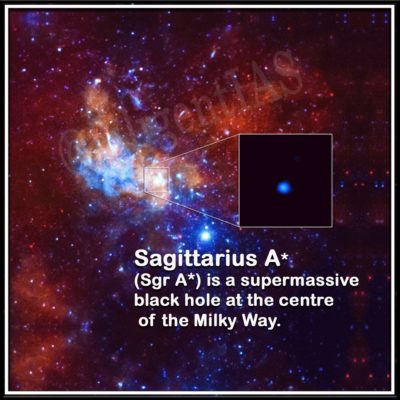Sagittarius A* (Sgr A*) a super-massive black hole in Milky Way 20/08/2019 – Posted in: Daily News
SAGITTARIUS A* (SGR A*)
For: Mains
Topics covered:
- What is Sagittarius A* (Sgr A*)?
- Why it suddenly glowed brighter?
- What did astronomers say?
- Information about Star SO-2 and G2.
News Flash
Sagittarius A* (Sgr A*) is a supermassive black hole at the centre of the Milky Way.
- It suddenly glowed brighter than its normal state becoming 75 times more luminescent before going back to its normal state.
- A team of astronomers said it was at its brightest form measured in near-infrared wavelengths.
- An astronomer said that the black hole became so bright that he first mistook it to be star S0-2.
Star SO-2
S2, also known as S0–2, is a star that is located close to the radio source Sagittarius A*, orbiting it with an orbital period of 16.0518 years, a semi-major axis of about 970 au, and a pericenter distance of 17 light hours (18 Tm or 120 au)—an orbit with a period only about 30% longer than that of Jupiter around the Sun, but coming no closer than about four times the distance of Neptune from the Sun.
Unnatural brightness of Sgr A*
Scientists are on a mission to find out the reason which led to the unnatural brightening of Sgr A*.
Findings
- Black holes do not emit any radiation on their own that can be detected by our current instruments.
- The other objects that are nearby emit radiation when the gravitational forces of a black hole generate immense friction which in turn produces radiation.
Why Sagittarius A* glowed 75 times more than its normal
There are two immediate possibilities, one is G2 and other is the star SO-2
G2
- G2 is thought to be a gas cloud, which approached within 36 light-hours of Sgr A* in 2014. It was later termed as a “cosmic fizzle”.
- The astronomers feel that the glowing of the black hole in May might have been a delayed reaction.
Star S0-2
Star S0-2 had passed close to the black Hole last year, it may have changed the way gas flows into the Back Hole, so more gas is falling on it, leading it to become more variable.
Way ahead
The only way to find out is by having more data, which is being collected across a larger range of wavelengths. The data may reveal different aspects of physics of the change in brightness, and help us understand what is happening to Sgr A*.
Important info
Scientists had earlier this year also discovered the only space object – a lone star, that managed to escape the force of Sgr A* black hole.
Source: Indian Express
Also, read more daily News
- Lead in polyvinyl chloride (PVC) pipes
- Corporate Social Responsibility
- RBI released the framework for Regulatory Sandbox
You are on the Best Online IAS preparation platform. You are learning under experts.
We are present on Facebook- Diligent IAS, LinkedIn- Diligent IAS, YouTube- Diligent IAS, Instagram- Diligent IAS. Get in touch with us.

